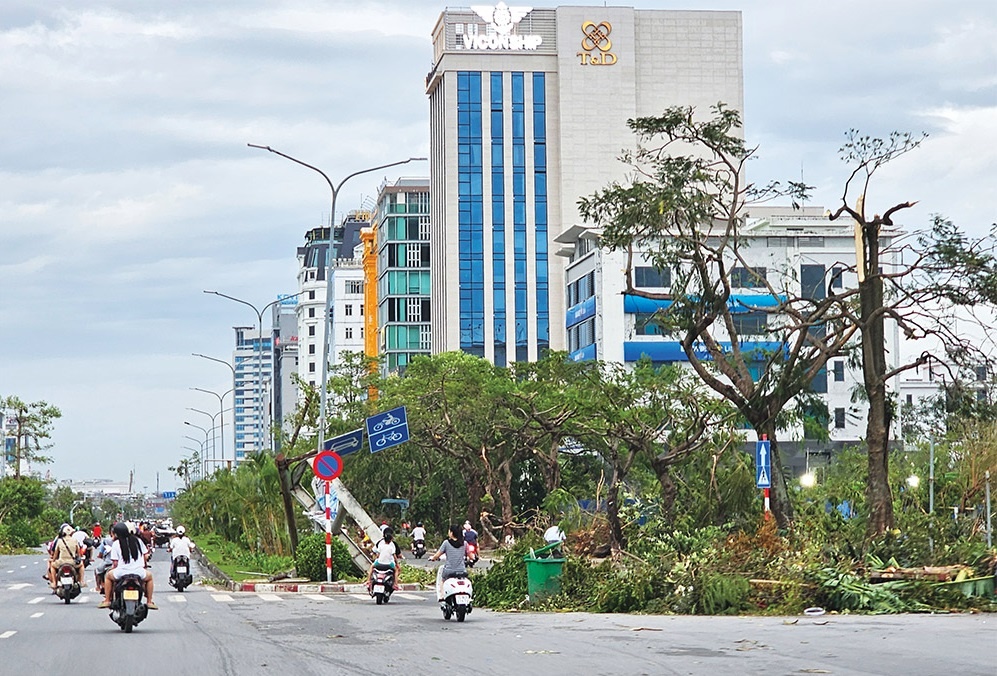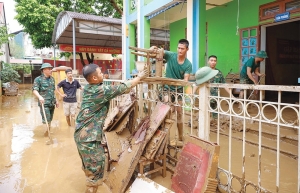Haiphong picks itself up after typhoon
Following Yagi’s landfall on September 7, transportation and communication lines in Haiphong were disrupted, with many roads flooded. Deep flooding paralysed traffic, while many households faced power and water outages.
According to information from Haiphong Power Company, around 400,000 of the city’s 500,000 electricity customers were unable to use electricity.
 |
| Haiphong’s power, highways, and telecoms services were affected, photo Thanh Son |
Quynh Nga, a resident of An Lao district, said, “From September 7-10, prolonged power and water outages made life very difficult. I had to buy water from stores while waiting for the supply to be restored. Although prices didn’t increase, the lack of water was inconvenient. Additionally, there was no phone signal, making communication challenging.”
Vu Van Khanh, a resident of Do Son district, told VIR, “We lost power and phone signal, so we couldn’t contact the outside world. My family stayed at home, hoping the storm would pass quickly. I’ve never seen such a prolonged typhoon with such strong gusts. Our food service and guest house business suffered heavy damage, estimated at over VND3 billion ($120,000).”
Typhoon Yagi also negatively impacted economic production activities in Haiphong. Bruno Jaspaert, general director of DEEP C Industrial Zones Vietnam, which has over 170 projects and factories in Haiphong and Quang Ninh province, said that its factories, hosting many large domestic and foreign companies with over 14,000 workers, was closed for some time.
“The typhoon caused widespread power outages, flooded highways, disrupted telecommunications, and halted economic activities. Some leaders and workers in Haiphong’s industrial parks (IPs) reported that by the end of September 8, they still had no electricity or internet and were struggling to protect equipment and goods from rain due to blown-away factory roofs,” Jaspaert said.
According to Le Trung Kien, head of Haiphong Economic Zones Management Authority, businesses in IPs experienced significant damage due to fallen trees, with damage rates ranging 30-90 per cent. Some areas faced localised flooding during the storm. Many businesses had their roofs blown off, walls torn or collapsed, and gates, fences, signs, camera systems, and rolling metal doors overturned.
According to Kien, businesses and IPs are urgently addressing the situation. By September 9, power was restored to all businesses, though they are taking steps to ensure continued electrical safety. Conditions for resuming smooth production, such as water and internet access, have largely been restored. By the morning of September 10, about 95 per cent of businesses in IPs had resumed operations.
Meanwhile, Cat Ba, a popular tourist destination in the area, was isolated from the mainland from September 6 to September 9. The island lost electricity, water, transportation, and telecommunications from September 7, and it was not until midday on September 9 that the first ferry resumed operation, allowing people from outside to see the storm’s aftermath on the island.
A resident of Cat Ba told VIR, “After the typhoon passed, the condition of Cat Ba town was devastating. Trees, metal roofs, refrigerators, and freezers were scattered on the streets. The strong winds first blew off metal roofs and glass, then shifted direction, breaking all the trees. Many newly built restaurants, operating for only a few months, suffered severe damage. Some of these newly invested restaurants lost over $40,000 due to wind damage to their facilities. The extent of the damage was beyond imagination.”
Since the typhoon occurred, Haiphong has been actively implementing measures to address the storm’s consequences. Haiphong Urban Environment Co., Ltd. has mobilised 140 specialised vehicles and nearly 1,500 staff members to collect and process waste after the storm.
At the same time, repairing essential infrastructure such as power supply, water supply, restoring communication systems, drainage, and environmental sanitation is also being prioritised to quickly bring people’s lives back to normal. Damaged roads that have not been repaired have also been marked to avoid dangers for road users.
| Typhoon Yagi crisis deepens as over 330 casualties reported According to the National Steering Committee for Natural Disaster Prevention and Control under the Ministry of Agriculture and Rural Development, as of September 13, there have been over 230 deaths and more than 100 people still missing. More landslides have occurred in Lao Cai, Yen Bai, Tuyen Quang, Cao Bang, and other locations. Fatal landslides were sometimes only reported a day after occurring due to disrupted communications and isolated transport routes. Lao Cai has the highest number of casualties, totalling 98 dead and 81 missing. Cao Bang reported a total of 43 dead and nine missing. Yen Bai has 48 dead and two missing, and Quang Ninh has recorded 15 deaths. In Phu Tho, there was at least one person declared dead from a landslide and another from flooding, and eight missing due to the collapse of Phong Chau Bridge. Hoa Binh reported seven dead from landslides, while Tuyen Quang reported five deaths from flooding. Over 800 people have been injured, with Quang Ninh suffering the highest number with over 530 injuries, followed by Haiphong with approximately 50 injuries. After suffering damage from the eye of Typhoon Yagi, Quang Ninh continues to face landslide risks. On the evening of September 11, Cam Pha evacuated over 130 households in areas at risk of landslides due to suspected waterlogging in high hill areas. The following day, Prime Minister Pham Minh Chinh visited the site to inspect and direct search, rescue, and relief efforts for victims and missing persons. Localities have evacuated over 74,500 households. The typhoon and floods have damaged 136,700 houses and submerged nearly 67,700 houses. Many shops, offices, and schools have been unroofed, and numerous advertising signs, telecommunication poles, and mobile transmission stations have collapsed. In agriculture, an estimated 202,000 hectares of rice fields have been inundated or otherwise damaged. Additionally, around 39,300ha of crops have been submerged in water, and fruit trees have suffered damage across almost 22,300ha. The disaster has also led to significant losses in livestock, with over 4,600 animals reported dead, as well as approximately 1,787,000 poultry. |
 | Vietnam's logistics sector hardest hit by Typhoon Yagi Vietnam's logistics sector was hit hard by Typhoon Yagi, with 82.4 per cent of businesses facing severe or moderate impacts, according to a new report by CEL. |
 | SABECO supporting localities hit by Typhoon Yagi Beer giant SABECO is working with the Ho Chi Minh Communist Youth Union (HCYU), local authorities, and partners to support the rebuild of northern provinces following the destruction brought by Typhoon Yagi. |
 | Hanoi endures widespread impact from Typhoon Yagi Typhoon Yagi, which made landfall in Hanoi on September 7, has caused major disruptions to infrastructure in the capital and surrounding areas. |
What the stars mean:
★ Poor ★ ★ Promising ★★★ Good ★★★★ Very good ★★★★★ Exceptional
 Tag:
Tag:
Related Contents
Latest News
More News
- Opening remarks of 14th National Party Congress (January 20, 2026 | 09:44)
- Vietnamese youth support 14th Party Congress with nationwide flag raising (January 20, 2026 | 09:37)
- Deputy Foreign Minister meets int’l journalists covering 14th National Party Congress (January 20, 2026 | 09:19)
- 14th National Party Congress convenes preparatory session in Hanoi (January 20, 2026 | 09:12)
- 14th National Party Congress opens preparatory session in Hanoi (January 19, 2026 | 17:42)
- National Convention Centre ready for 14th Party Congress (January 19, 2026 | 12:05)
- Key highlights of 14th National Party Congress (January 19, 2026 | 09:00)
- First working day of 14th National Congress of Communist Party of Vietnam (January 19, 2026 | 08:54)
- 14th National Party Congress – significant moment for Vietnamese people, international friends (January 18, 2026 | 18:00)
- 14th National Party Congress expected to shape Vietnam’s path to 2045 (January 17, 2026 | 16:00)























 Mobile Version
Mobile Version